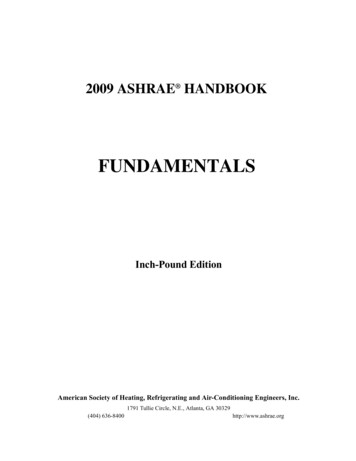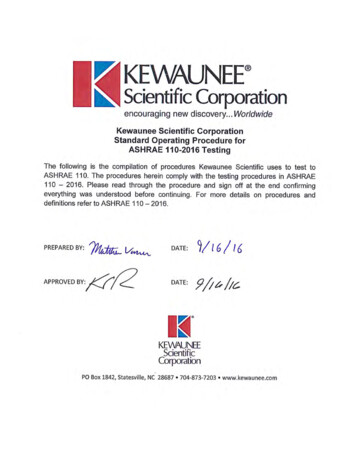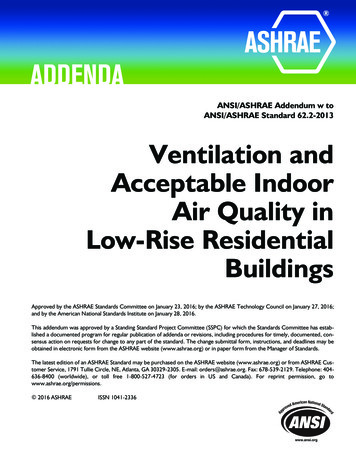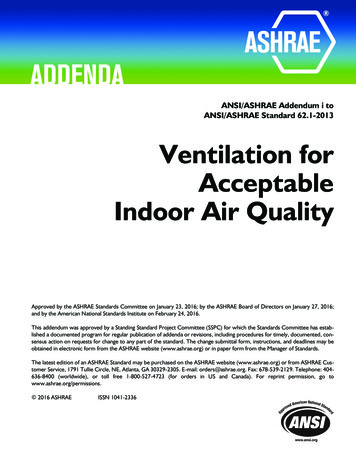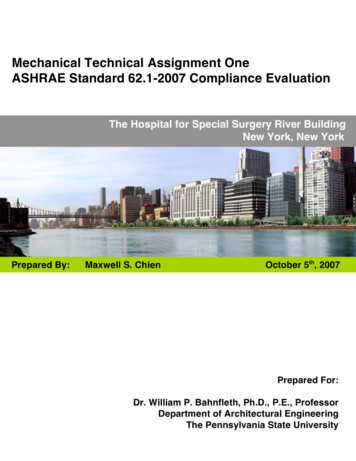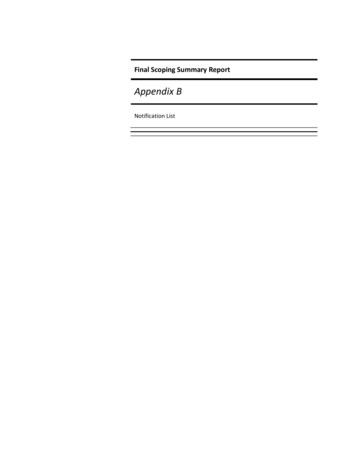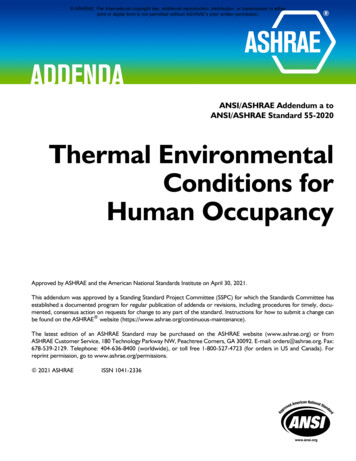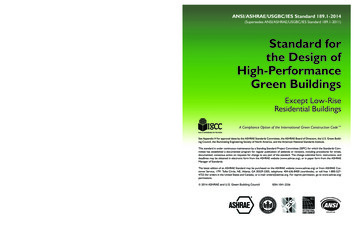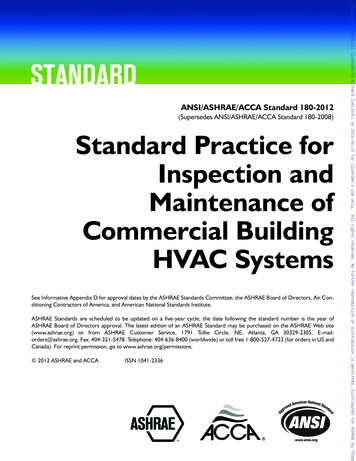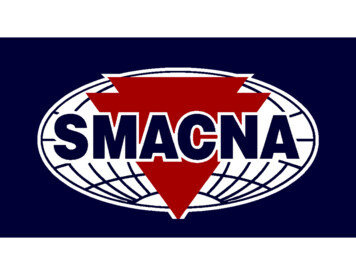
Transcription
SMACNA Technical ServicePresented By:Patrick J Brooks, P.E. - Senior Project Manager
Duct Design FundamentalsLearning Objectives Basic Air Flow Pressure Pressure Losses - Friction Pressure Losses – Dynamic Fitting Efficiencies Duct Design Overview Duct Design – Equal Friction Duct Design – Static Regain Acoustics Commissioning
Duct Design FundamentalsBasics of AirFlow
Mass Flow and ContinuityEquationsMass flow into a section mass flow out of a sectionṁ ρAdV constantIf air density is constant, we get the Continuity Equationṁ Q AdV constantρ
Duct Areas2Round: Ad 4Rectangular : Ad WHFlat Oval: Ad ( a2 ) a (A-a)4
VelocityIf Q and A are known, the duct velocity, V can be calculated.V AdExample 1: If the volume flow rate in a 22 in. duct is, Q 5000 cfm, what is the averagevelocity of air in the duct.D 22 inch (1.83 ft)Ad 𝜋 1.8342 2.64 ft2V 5000 / 2.64 1894 fpm
Calculate Duct Size for aGiven VelocityV Ad Ad Example 2: If the design volume flow rate and velocity is 13,000 cfm and 4000 fpmrespectively, what is the H dimension in a rectangular duct if the W dimension is 14 inchesAd Q / V 13,000 / 4000 3.25 ft2 (Multiply by 144 to get in2) 468 in2Ad WH - H Ad / WH 468 / 14 33.4 inches
Diverging FlowAccording to the law of conservation of mass, the volumeflow rate before flow divergence is equal to the sum of theflows after divergence.Qc Qb QsWhere:Qc common (upstream) volume flow rate, cfmQb branch volume flow rate, cfmQs straight-through volume flow rate, cfm
Converging FlowAccording to the law of conservation of mass, thevolume flow rate after flow convergence is equal to thesum of the flows before convergenceQc Qb QsWhere:Qc common (downstream) volume flow rate, cfmQb branch volume flow rate, cfmQs straight-through volume flow rate, cfm
Duct Design FundamentalsPressure
CONSERVATION OF ENERGYpt ps pvWhere:pt total pressure, in. of waterps static pressure, in. of waterpv velocity pressure, in. of water
Duct Design FundamentalsPressureThe inch of water is defined as the pressure exerted atthe base of a column of fluid exactly 1 inch (in) high27.7 inch of water per 1 psi (lbf /in2 )1 inch of water is 5.2 psf ( lbf /ft2 )1 inch of water is 0.036 psi
Duct Design Fundamentals Static Pressure (ps)Measure of the static energy of air flowingAir which fills a balloon is a good example of static pressureEqually exerted in all directionsThe atmospheric pressure of air is a static pressure 14.696 psi at sea level. One psi 27.7 in. of water, so 1 atm 407 in. of water. Air always flows from an area of higher pressure to an area of lower pressure. Because the static pressure is above atmospheric pressure at a fan outlet, air will flowfrom the fan through any connecting ductwork until it reaches atmospheric pressure at thedischarge Because the static pressure is below atmospheric at a fan inlet, air will flow from thehigher atmospheric pressure through an intake and any connecting ductwork until itreaches the area of lowest static pressure at the fan inlet.
Duct Design FundamentalsVelocity Pressure (pv) Measure of the kinetic energy of the air flowing in a duct system Proportional to the square of the velocityp𝑣Where:pv velocity pressure, in. of waterV velocity, ft/minρ density, lbm/ft3p𝑣
Duct Design FundamentalsVelocity Pressure (pv) Velocity pressure (pv) is always a positive number in thedirection of flow. Will increase if duct cross‐section area decreases. Will decrease if duct cross‐sectional area increases. When velocity pressure increases, static pressure mustdecrease. When velocity pressure decreases, there can be a gain instatic pressure, commonly called STATIC REGAIN.
CONSERVATION OF ENERGYChange in total pressure between any two points of asystem is equal to the sum of the change in static pressureand the change in velocity pressureΔpt Δps ΔpvDerived from the Bernoulli Equation:𝑝𝜌 𝑉2𝑔𝑔𝜌 𝑧𝑔𝑝𝜌 𝑉2𝑔𝑔𝜌 𝑧𝑔 𝑝,
Duct Design FundamentalsPressure Changes During Flowin Ducts Total pressure (pt) represents the energy of the air flowing in a ductsystem. Energy cannot be created or increased except by adding work or heat Energy and thus total pressure must always decrease in the directionof flow once the fan is turned on except at the fan . Total pressure losses represent the irreversible conversion of staticand kinetic energy to internal energy in the form of heat. These losses are classified as either friction losses or dynamic losses.
Duct Design FundamentalsPressure Changes During Flow inDucts – Graphically
Duct Design FundamentalsPressure Losses in Duct SystemsTwo Types of Losses
Duct Design FundamentalsPressure LossesDarcy-Weisbach EquationDarcy-Weisbach Equation
Duct Design FundamentalsDarcy-Weisbach EquationDhAdAdAdwhich is known as Hydraulic Diameter.,PRound, P 2 (W H),PRectangulara 2(A‐a)Flat Oval
Duct Design FundamentalsPressure Losses – FrictionThe left‐hand side of the Darcy‐Weisbach Equation,which is the Darcy Equation, calculates the friction loss.
Duct Design FundamentalsPressure Losses – FrictionColebrook EquationType equation here.The Colebrook equation was developed to calculate the friction factor, f, requires you to also know the ReynoldsNumber, Re and the absolute roughness, ε, which is determined experimentally. Values of ε are available in the A‐1, pg A.4. A common12.51 SMACNA HVAC SYSTEMS DUCT DESIGN MANUAL, FOURTH EDITION – DECEMBER2006, Table is based on. The2 logchartvalue to remember is 0.0003 ft for standard galvanized material which is what the friction f 3.7 Dh Re f Colebrook equation value of f must be solved for iteratively
Duct Design FundamentalsPressure Losses – FrictionType equation here. 12.51 2 log f 3.7 Dh Re f
Duct Design FundamentalsPressure Losses – FrictionReynolds NumberThe Reynolds Number, Re is the ratio of the inertia force to the viscous forcecaused by changes in velocity.ℎThe Reynolds Number is calculated from:Air density (ρ) and dynamic viscosity (μ) are obtained from or by using a2.51 1 a Handbook 2 log calculator with psychometric routines. 3.7 DhfAt standard air Conditions:ℎRef
Duct Design FundamentalsPressure Losses – FrictionComparison of Different Velocities and MaterialsExample: Calculate the Friction Loss in 100 ftof rectangular duct 24” x 32” at 1000 fpm, 2000fpm, 3000 fpm and 4000 fpm for standardgalvanized metal (ε 0.0003 ft) and 1 lined duct2.51 2log (ε 0.003 ft) 3.7 DRe ffh
Duct Design FundamentalsPressure Losses – FrictionType equation here. 12.51 2 log f 3.7 Dh Re f
Duct Design FundamentalsPressure Losses – FrictionComparison of Different Velocities and Materials
Duct Design FundamentalsPressure Losses – FrictionComparison of Different Velocities and RoughnessObservations: Factor of 15 increasing pressure loss from 1000 – 4000 fpm 0.04 to 0.60 inch water Factor of 1.5 increasing ε by a factor of 10 0.02 to 0.32 inch of water increase
Duct DesignFundamentalsUsing a FrictionLoss ChartExample: 1000 cfm in 10” DiaResult: 0.40 in wg/100 ft
Duct Design FundamentalsPressure Losses – FrictionEquivalent Duct Sizes for Same Friction LossShape Options Most duct systems are originally sized with round ducts. For many reasons (headroom, available equipment), the designer or engineer may want to use anequivalent rectangular or flat oval size. The following equations calculate the round duct diameter that will give the samefriction loss as the rectangular or flat oval duct, at the same volume flow rate (cfm). Most of the time however, the round size is known, and the designer wants todetermine one of the dimensions of the rectangular or flat oval section. (Forexample, the ceiling area may only allow a 12‐inch minor axis).
Duct Design FundamentalsPressure Losses – FrictionEquivalent Duct Sizes for Same Friction Loss.Rectangular:De 1.55 1.30.Flat Oval:De 1.55. .Because of the power relationships these must also be solved iteratively to get the original equivalent round size.Fortunately tables, ductulators, spreadsheets and other programs have been created to calculate the equations.See Appendix A, Tables A‐2 and A‐3 of the SMACNA HVAC SYSTEMS DUCT DESIGN manual – FOURTH EDITION –DECEMBER 2006
Duct Design FundamentalsPressure Losses – FrictionEquivalent Duct Sizes for Same Friction LossFrom:Example: 12 x 7 Rectangular, 1000 cfmSolution: From Table A-2 , the Equivalent Round Size is 9.9 inches. Use the friction chart at1000 cfm in 9.9 inch Diameter to, friction loss is 0.4 in water/100 ftTypo,“Circulation”should be“Circular”
Duct DesignFundamentalsUsing a FrictionLoss ChartExample: 1000 cfm in 10” DiaResult: 0.40 in wg/100 ft
Duct Design FundamentalsPressure Losses – FrictionEquivalent Duct Sizes for Same Friction LossFrom:Example: 12 x 7 Flat Oval 1000 cfmSolution: From Table A-3 , the Equivalent Round Size is 9.4 inches. Use the friction chart at1000 cfm in 9.4-inch Diameter to, friction loss is 0.5 in water/100 ft
Duct DesignFundamentalsUsing a FrictionLoss ChartExample: 1000 cfm in 10” DiaResult: 0.50 in wg/100 ft
Duct Design FundamentalsPressure Losses in Duct SystemsTwo Types of Losses
Duct Design FundamentalsPressure LossesDarcy-Weisbach EquationDarcy-Weisbach Equation
Duct Design FundamentalsPressure Losses – DynamicThe right‐hand side of the Darcey‐Weisbach Equation,which is the Weisbach Equation, calculates the dynamicloss.,
Duct Design FundamentalsPressure Losses – Dynamic Experimentally determined loss coefficients are generally used to calculate total pressure dynamiclosses for fittings or components. Loss coefficients are a function of velocity pressure, pv If the section velocity pressure is used, all loss coeffients can be added and multiplied by the sectionsvelocity pressure to determine the dynamic losses for the sectionΔ𝑝𝐶 𝑝, If the common velocity pressure is used , then the individual losses must be totaled.Δ𝑝,𝐶 𝑝
Duct Design FundamentalsPressure Losses – How Loss Coefficients are Determined,,Every fitting has associated loss coefficients, which can be determinedexperimentally by measuring the total pressure loss through the fitting forvarying flow conditions. Often the pressure loss is regressed vs the velocitypressure and the slope of the regression is the loss coefficient.
Duct Design FundamentalsPressure Losses – How Loss Coefficients are DeterminedΔpt,1-2 Δps,7-8 (pv7 – pv8) – (L7-1Δpf,7-1 L2-8Δpf,2-8),L7‐1 is the measured length from theupstream static pressure measurementplane to the center point of the fitting, andL2‐8 is the measured length from the centerpoint of the fitting to the downstream staticpressure measurement plane
Duct Design FundamentalsPressure Losses – How Loss Coefficients are Determined, Diverging FlowL7-1, L2-8 and L3-9are measured to thecenterline of the fittingMain: Δpt,1-2 Δps,7-8 (pv7 – pv8) – (L7-1Δpf,7-1 L2-8Δpf,2-8)Branch: Δpt,1-3 Δps,7-9 (pv7 – pv9) – (L7-1Δpf,7-1 L3-9Δpf,3-9),CsCb,
Duct Design FundamentalsPressure Losses – How Loss Coefficients Branch Fittings are Determined when Referencedto the Common SectionFor diverging flow , if the losscoefficient is referenced to theupstream velocity pressure,Since the total pressure losshas to be the same, then:𝑠𝑒𝑐𝑡𝑖𝑜𝑛𝑣 , 𝑠𝑒𝑐𝑡𝑖𝑜𝑛, or𝑠𝑒𝑐𝑡𝑖𝑜𝑛 ���𝑣𝑢𝑣𝑢𝑣 , 𝑠𝑒𝑐𝑡𝑖𝑜𝑛
Duct Design FundamentalsPressure Losses – How Loss Coefficients are Determined, Converging FlowL7-1, L2-8 and L9-3are measured to thecenterline of the fittingMain: Δpt,1-2 Δps,7-8 (pv7 – pv8) – (L7-1Δpf,7-1 L2-8Δpf,2-8)Branch: Δpt,3-2 Δps,9-8 (pv9 – pv8) – (L9-3Δpf,9-3 L2-8Δpf,2-8),CsCb,
Duct Design FundamentalsPressure Losses – How Loss Coefficients Branch Fittings are Determined when Referencedto the Common SectionFor converging flow , if the losscoefficient is referenced to thedownstream velocity pressure,𝑢Since the total pressure losshas to be the same, 𝑖𝑜𝑛𝑣 , 𝑠𝑒𝑐𝑡𝑖𝑜𝑛 or𝑠𝑒𝑐𝑡𝑖𝑜𝑛 𝑢𝑑,𝑢𝑑𝑣𝑑𝑑𝑣𝑑𝑣 , 𝑠𝑒𝑐𝑡𝑖𝑜𝑛
Duct Design FundamentalsLoss Coefficient Tables Loss coefficients are often published in table form or equations. See tables A‐7 toA‐15 in the HVAC SYSTEMS DUCT DESIGN manual. If a branched fitting, check to see what referenced velocity pressure is used. If non‐standard conditions are encountered, use the density correction factorsfrom Figure A‐4Example: 10” Dia, 90 Smooth Radius Elbow, R/D 1.5.Airflow is 1000 acfm. Elevation is 5000 ft.
Duct Design FundamentalsLoss Coefficient TablesTable A-7A, page A.15Solution: Area (π x 102/4)/144 0.55 ft2Velocity 1000/0.55 1833 fpmVelocity pressure at standard conditions, pv (1833/4005)2 0.21 inch of waterC 0.15 from Table A‐7A, Ke from Figure A‐4, A.14 (elevation correctionfactor for density) 0.83
Duct Design FundamentalsLoss Coefficient Tables
Duct Design FundamentalsLoss Coefficient TablesΔpt 0.15 x 0.21 x 0.83 0.03 inch of water
Duct Design FundamentalsLoss Coefficient TablesExample: Diverging Tee 45 Rectangular Main and Branch.Main is 10” x 10”, Branch is 7” x 7“. Airflow Main is 1000cfm. AirFlow Branch is 500 cfm. Standard air.
Duct Design FundamentalsLoss Coefficient TablesPage A.33Vp pvc
Duct Design FundamentalsLoss Coefficient TablesSolution: Area Main, Ac (10 x 10) /144 0.69 ft2Area Branch, Ab (7 x 7) /144 0.34 ft2Velocity, Vc 1000/0.69 1440 fpmVelocity, Vb 500/0.34 1469 fpmVelocity pressure pvc (1440/4005)2 0.13 in H20Velocity pressure pvb (1469/4005)2 0.13 in H20Velocity Ratio, Vb / Vc 1469/1440 1.02Flow Rate Ratio, Qb / Qc 500/1000 0.50
Duct Design FundamentalsLoss Coefficient TablesPage A.33Table A‐11N, Cb 0.74Δpt,c‐b 0.74 x 0.13 0.10 inch waterWhen the downstream section of the main stays thesame diameter, the loss coefficient i
SMACNA HVAC SYSTEMS DUCT DESIGN MANUAL, FOURTH EDITION –DECEMBER 2006, Table A‐1, pg A.4. A common value to remember is 0.0003 ft for standard galvanized material which is what the friction chart is based on. The Colebrook equation value of f must be solved for iteratively
